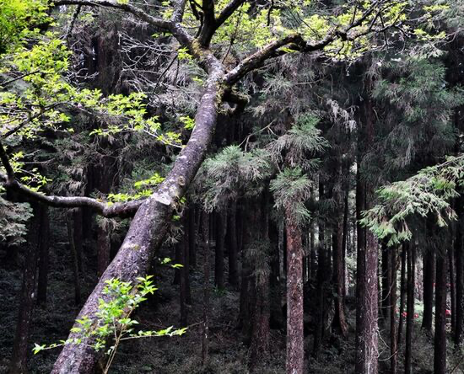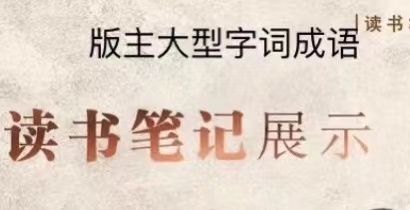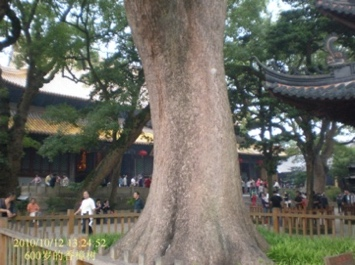In July of 2015, Meilan Zhang also retired and we went to Australia to look after our grandson Peter Song, starting our journey life at the same time. I wrote my resounding goal in my QQ room: Reading over Tens and Thousands of volumes of Books, Travelling Tens and Thousands of Miles and Writing Hundreds of and Thousands of Characteristics. Section 54 narrated the places we had been to during the first five years after the retirement: along the silk road to Dunhuang and Xinjiang; getting to Thailand and watching the palace and shemale show; flying to Yunnan, visiting minority nationalities, and touring Xishuangbanna virgin forest; arriving at the ancient city Xi’an, and having a look at terra cotta warriors of Qin Dynasty; climbing Huangshan and enjoying seeing sturdy pines and marvelous stones; touring Sichuan and Hubei, and travelling Jiuzhaigou, Emei Mountain, big and small three gorges and Three Gorges Dam, and etc. Section 56 recorded our travelling to the eastern parts of the US and Canada. Section 58 was about us travelling in Washington and Philadelphia in America. Section 59 narrated Shanghai Expo and several cross-river and cross-sea bridges in Shanghai and Zhejiang. Section 62 said something about our journey to London and meeting with Prof. Quirk. Section 63 was about our travelling to Tibet of 5000-meter altitude and taking a full sight of the Yarlung Zangbo River’s chasm view. Section 64 and 65 recorded our journey to San Francisco, enjoying seeing red-wood trees in Yosemite, and visiting desert casino city Las Vegas. The subject of this section continues to be our journey from Oct. 2012 to May 2015, including to Hunan, Taiwan, Shanxi, Fujian, Jiangxi, Guizhou and Austria and Italy in South Europe.
Journey to Hunan
On the evening of Oct. 31, 2012, we took the train to Yueyang City of Hunan Province, where we climbed up the historical famous building, Yueyang Tower, which stands on the side of Dongting Lake. During the senior middle school we studied the text “Yueyang Pavilion”written by Fan Zhongyan, which has been engraved on our minds. Now in our old age we could come sightseeing, and it was unavoidable that we were filled with a thousand regrets. However, it would help me to write the history of North Song Dynasty later.

Yueyang Pavilion
Next we arrived at the National Forest Park, Zhangjiajie Scenic Area, which is famous at home and abroad. The scenery of Zhangjiajie is as beautiful as that described in fairy tales, rows of mountain peaks rise straight from the ground, with different postures, but having similarities. Peak walls are absolutely steep, but green with all kinds of trees and grasses. We rode a straight up elevator to the top of the mount, enjoying the sight of marvelous scenery we had never viewed.

Scenery of Zhangjiajie
When you get to Hunan Province, you should go to Shaoshanchong, Mao Zedong’s home town. In order to add to the income, Mao has been deified and the employees there asked tourists to pay out of their own pockets, which caused me to resist. At 4:30 p.m. of Nov. 11 we returned home, ending one-week journey life.
Journey to Taiwan
The journey to Taiwan is turned very easy and convenient because we can take off from the Guanyin Airport of Xuzhou directly to Taibei. On Jan, 23, 2013, we arrived at Taoyuan Taibei Airport, 8 days’ journey and returned on Jan. 30. We almost always took the tour bus, from the north to the south clockwise, namely first along the east coast, then the west, when we went inside to get to famous Ali Mountain and Riyuetan Pool scenic areas. Riyuetan Pool is surrounded by hills with forest trees, the pool water sparkling and crystal-clear, oneness of sky and water. There is a small island in the middle of the lake, forming the beautiful scenery of “green mountains embracing the clear water and bright pool surrounding the pear”. Peaks of Ali Mountain are surrounding, ranges upon the ranges of green hills and giant trees towering into the sky. Junipers impressed upon us very deeply, some of which are more than a thousand-year old, called mysterious red junipers of Ali Mountain. They grow in the remote, high and cold mountains, and stand erect for thousands of years.
|  |
Mysterious Red Junipers. Riyuetan Pool scenic areas
Journey to Shānxi
From Sept. 9 to 15 of 2013, we toured in Shānxi Province for a week, entering its northern part, and first getting to Wutai Mountain. Wutai Mountain is one of the four Buddhism famous mountains of China. “Famous mountain Chronicles” says that Wutai (five platforms) Mountain has five peaks standing up, higher above clouds, on whose tops there are no trees, just like platforms of base soils, namely East Platform, West Platform, South Platform, North Platform and Middle Platform, altogether five platforms. Wutai Mountain has 47 temples, smoked and terribly hot everywhere, fragrant fire flourished. China has four famous Buddhism mountains, namely Wutai Mountain, Emei Mountain, Putuo Mountain and Jiuhua Mountain, where the legend says that the four bodhisattvas were practicing respectively: the Bodhisattva Manjusri, Samantabhadra Bodhisattva, Guanyin Bodhisattva and Earth Store Bodhisattva, all of which have religious culture sources of a long history, and are famous scenic attractions of China as well.
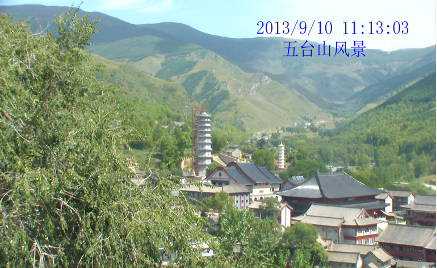
Wutai Mountain
On Sept.14 we arrived at the Stork Tower, which stands on the eastern bank of the Huanghe River in the west of the ancient city of Puzhou, Yongji City, Shānxi Province and was first constructed during the North Zhou Dynasty. Because the main structure of the tower was magnificent and the framework ingenious, plus beautiful sceneries around it, scholars and men of letters during the Tang and Song Dynasties climbed the tower enjoying the sceneries and left a lot of immortal poems, the most famous of which was Wang Zhihuan’s Mounting the Stork Tower: “The white sun sets behind mountains, The Yellow River flows into the sea. Go further up one flight of stairs, and you'll widen your view a thousand li.” In Dec. of 1997, the reconstruction project of the Stork Tower began with digging for the foundation, which was decided by the government of Yongji City. The Tower was ruined during the first years of the Yuan Dynasty and more than 700 years had passed. On Sept. 26 of 2002, the new Stork Tower began to receive the visitors.

Stork Tower
Hukou Waterfalls’ location is close to Hukou Town, Yichuan County, Yan’an city, Shǎnxi(陕西)in the west and Hukou Town, Jixian County, Linfen City, Shānxi(山西)in the east, therefore it is the common scenic spot shared by the two provinces. Hukou Waterfalls, the second largest fall of China, is the largest yellow fall in the world. The Huanghe River is rushing to this place, stonewalls on both sides rise steeply and the river mouth is contracted like a mouth of a pot, so it is called Hukou (pot mouth) Falls. The upstream of the fall is 300 m wide and in the distance less than 500m, it is reduced to 20-30 meters wide. 1000 cubic meters’ water per second streams down from 20 m high, forming the surprising scene of thousands of miles Yellow River pouring down into a pot.

Hukou Waterfalls
Journey to Fujian
On Sept. 23, 2013, we went to Fujian with our friends Mr. Youci Zhang and Ms. Yanrong Ma in a journey bus, and returned on 29, just one week. We visited Kakkas and their Earthen Building in Yongding County, which lies Longyan region of west Fujian and where Hakka dwellings with different styles are distributed called “Yongding Kakkas Earthen Buildings”. Earthen Buildings are divided into round and square buildings and in Yongding County there are round earthen buildings more than 360 and square buildings more than 400, one of World Cultural Heritages. Chengqi is a round earthen building which we visited and where we stayed at night. It is located in Gaobei Village, Gaotou Town, Yongding District, Longyan City. It is said that the ground was broken for laying a cornerstone during the Chongzhen years of Ming Dynasty, and completed in Kangxi years of Qing Dynasty, experiencing three generations, a half century. Large scale, peculiar shape, antique flavor and full of country flavor. It is four-store round building with 400 rooms, round in round, circle in circle, experiencing 300 years.
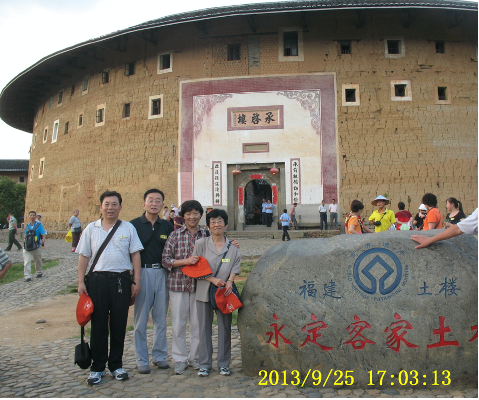
Yongding Kakkas Earthen Buildings
The name of prestigious Kulangsu comes from the fact that there is a reef on the southwestern beach, which is two meters high and has a cave in the middle. When the tide comes and the waves attack the reef, it gives a loud sound like beating the drum and Kulang means drum and tide. The streets on Kulangsu are short, arranged in a crisscross pattern, which is the largest island of Xia’men. We rode in a sightseeing boat, cruised around the island and then went ashore, wandering in almost all the long and short streets.

On the sightseeing boat, the background is Kulangsu
We also visited the former residence of the patriotic overseas Chinese Jia’geng Chen and the Jimei Middle School created by him.

Jimei Middle School
Journey to Jiangxi
On April 12, 2014, we old pair went to Jiangxi Province, the first station being Wentang Town, Yichun City, where the center of the geothermal hot spring is 168 m altitude and the hot spring is gushing from the granite in the deep stratum. The amount of hot water each day reaches more than 10000 tons, and the temperature during the whole year remains 68℃—72℃, colorless and odorless, fine and smooth, not containing any sulphur, with low mineralization degree, low sodium (Na), rich selenium, and high content of silicic acid. The hot spring with rich selenium has a history of 800 years, rare in China and the whole world. Hot spring fans rend rooms and houses there and even buy, making the house price rise rapidly. We saw two wells, and each area was as that of a bathing pool of the public bathhouse. The spring level is so high that you can carry hot water by bending your waist or with a bucket having a short rope. Tourists carried hot water from the well and let their legs and feet soak in it. At the beginning, the water was too hot and they had to wait a moment before their feet and legs could be put in it. Hot spring fans came from all over the country, and they washed their legs and feet and chatted merrily. In my video files there is one named “journey to Jiangxi”, which was utmost vivid, and you can watch it.
Starting off from Wentang Town we travel to Jing’gang’shan Mountain, which is difficult to climb. A lot of old tourists gave up climbing. The right lame leg of mine braced me and finally I reached the top.
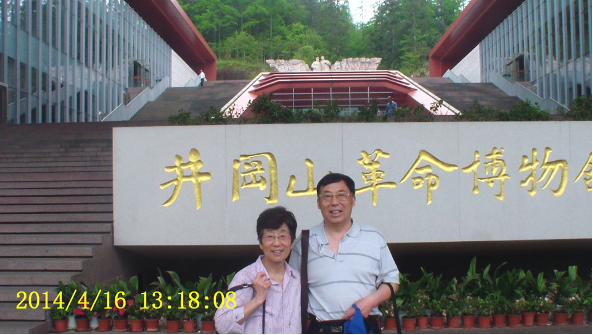
On Jing’gang’shan Mountain
When you get to Jiangxi, you should go to the porcelain capital Jingdezhen City. We entered the museum of ceramics, watched the whole process of making a porcelain billet, wandered through the porcelain streets, and made an order for porcelain teacups, which would be presents for all our classmates studying German who would get together to celebrate 50 years’ anniversary of our entering Nanjing University.
When you get to Jiangxi, you should also go to Prince Teng Pavilion, which is one of the three famous pavilions in the south of the Yangtze River. Prince Teng Pavilion is located on the eastern bank of Gangjiang River, northwestern along the river road of Nanchang City. Young talent Wang Bo’s “preface of Pavilion of Prince Teng” has been immortal for thousands of years, from which the idiom “The east corner is gone, and mulberry trees are not late.” has encouraged me forever. “the east corner” means where the sun is rising, indicating the early years of one’s life; mulberry trees refer to the sunset, namely old age. The early years have passed, and it is not late for you to cherish the future years. In my video files there is also the video of Prince Teng Pavilion. You can have a look at it.
At last we got to Lu’shan Mountain. You can’t know the real features if you do not see it yourself. The bus turned 400 curves before it got to the top. A poem by Mao Zedong says: One mountain stands erect on the riverside, jumping to its verdant top by 400 turns.” What you cannot think of is that there is a beautiful wide lake on the top, named Ruqin Lake and so many residents are living here that primary schools and middle schools are built for their needs, and commercial facilities are all in readiness.
Journey to Guizhou
At 9:51, Nov. 3 of 2014, we took the train to the home of our old friend Li Jian in Nanjing, whose wife was also our acquaintance. On the next early morning we took a taxi to the South Railway Station of Nanjing and then got on the light rail to the Luokou Airport. The plane took off at 7:40 and we arrived at Guiyang at 11:00. The distinguishing feature of Guiyang’s natural scenery is all kinds of falls, the most famous being the Huangguoshu Fall and Xiaoqikong and Daqikong falls, which we cannot forget. The Huangguoshu Fall has large discharge of water and you can go behind it, realizing a minus distance contact; group waterfalls in Xiaoqikong are falling from tops of the mountains around you and you can be in the middle of them, so many falls coming into sight that your eyes are kept fully occupied. If you have interests, you can open the video file in my video folder called “journey to Guizhou”.
Journey to South Europe
Our classmate Naiyun Cao is my fellow county’s man. We established the deep friendship during the period when we studied German in Nanjing University. At that time during the summer or winter holidays we visited each other’s home and my brothers and sisters got familiar with him and our next generations got to know each other although they live far away from each other, living in Europe, America and Australia respectively. His wife Lanying Zeng is also familiar with us and when we returned from Australia and stopped in Shanghai, we were sure to meet and talk with each other in a friendly way. They old pair also came to Xuzhou, visiting the ancient city. They have two daughters and both are in Vienna. The elder Ying Cao has a tour company, which attracted us to travel to South Europe. We have been to western Europe and Britain, we are anxious to visit Austria and Italy. On May 19, 2015, we took a Russian air flight to Moscow, from which we transferred to Vienna. Naiyun Cao and Ying Cao picked us up at the airport.
Ancient city of Rome and Venice water city impressed upon us deeply. You can open my video files in the video folder called “journey to South Europe” to have a look.
Nov. 12, 2018 in Xuzhou
Proofreading on Jan 7 2019 in Xuzhou
Uploading on Aug. 11 2023 in Xuzhou


